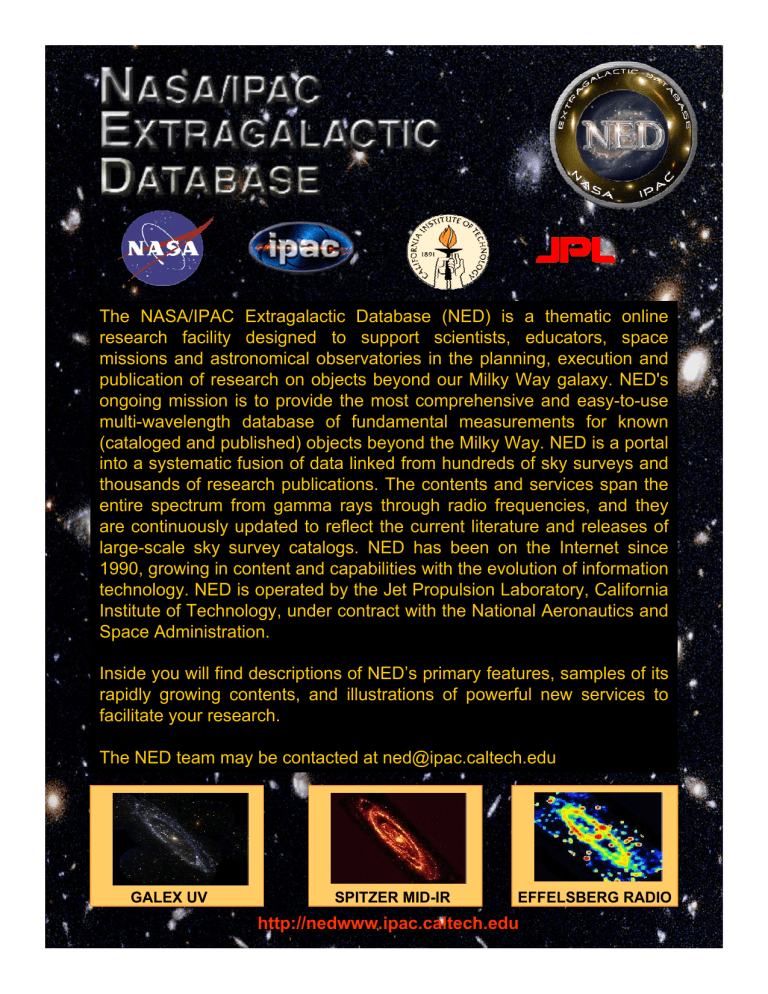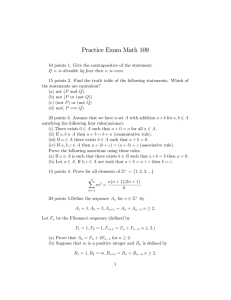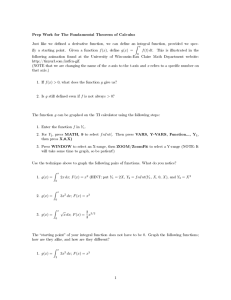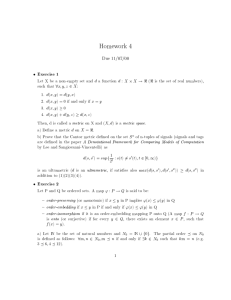The NASA/IPAC Extragalactic Database (NED) is a thematic online

The NASA/IPAC Extragalactic Database (NED) is a thematic online research facility designed to support scientists, educators, space missions and astronomical observatories in the planning, execution and publication of research on objects beyond our Milky Way galaxy. NED's ongoing mission is to provide the most comprehensive and easy-to-use multi-wavelength database of fundamental measurements for known
(cataloged and published) objects beyond the Milky Way. NED is a portal into a systematic fusion of data linked from hundreds of sky surveys and thousands of research publications. The contents and services span the entire spectrum from gamma rays through radio frequencies, and they are continuously updated to reflect the current literature and releases of large-scale sky survey catalogs. NED has been on the Internet since
1990, growing in content and capabilities with the evolution of information technology. NED is operated by the Jet Propulsion Laboratory, California
Institute of Technology, under contract with the National Aeronautics and
Space Administration.
Inside you will find descriptions of NED’s primary features, samples of its rapidly growing contents, and illustrations of powerful new services to facilitate your research.
The NED team may be contacted at ned@ipac.caltech.edu
January 2007
GALEX UV SPITZER MID-IR http://nedwww.ipac.caltech.edu
http://nedwww.ipac.caltech.edu
EFFELSBERG RADIO
1
NED in a Nutshell
Multi-wavelength
Cross-IDs
Basic Data
Derived Values
Details on page 4.
Primary NED Services
NED is the world's largest database of cross-identified extragalactic objects, containing approximately 10 million unique objects and 15 million multi-wavelength cross-IDs. Over 3 thousand catalogs and published lists covering the entire electromagnetic spectrum have had their objects cross-identified or associated and their data fused into the database for easy queries and retrieval.
Objects can be queried By Name (any alias) using the NED name interpreter; Near Name or Near Position (cone search); By
Reference (Refcode), and By Author. By Parameter (Advanced All-
Sky) queries utilize joint constraints on Redshift, Sky Area, Object
Types, Survey Names, and Flux density/magnitude to construct galaxy samples. The complexities of SQL are hidden from the user by the NED software and interface.
Available data include Positions, Redshifts, Morphological and
Spectral Classifications, Photometry, Images, Spectra (New!),
Diameters, Cross-IDs, Associations, Reference Abstracts and detailed Notes. Measurement uncertainties are included where available, and all information is cited and linked to the on-line literature via ADS.
Other tools include a Coordinate Calculator that performs conversions and precession and displays line-of-sight Galactic extinction estimates; a Velocity Calculator that converts between
Heliocentric, Local Group, Galactic Standard of Rest, and 3K
Microwave Background; and an XY-Offset to RA/Dec converter.
Links into NED: Photometry,
Images, Diameters, Positions,
Redshifts, Spectra, Notes.
Links to
External
Archives
Seamless Connectivity
Globally distributed services are linked by object names and positions in NED. See page 5 for details.
Knowledgebase for Extragalactic
Astronomy & Cosmology
See page 10 for details.
January 2007
Links to On-line Literature
Data in NED are cited and linked to the on-line journals via
ADS. Abstracts may be queried individually from specific data entries, or in groups By Object, By Author, or full Text Search.
http://nedwww.ipac.caltech.edu
2
ARP 220
3C 273
Spectral Database
See page 8 for details.
NED in a Nutshell
Spectral Energy Distributions
NED provides Spectral Energy Distributions
(SEDs) covering the whole electromagnetic spectrum. Fluxes and their uncertainties
(or upper limits), gathered from large survey catalogs and from the literature, are displayed in various user-requested standardized units.
Aperture information and ties to the originating literature are provided for every data point.
Great care goes into understanding and documenting the details of the measurements
(metadata), and the data are provided to users in original published units (magnitudes, Janskys, etc.), and uniformly converted to various standard units for display and SED plotting.
Multi-wavelength Images and Visualization
NED provides a unique collection of images which are interconnected, documented, and available for queries and immediate download. The science-grade images in FITS format are highly processed data submitted by researchers around the world after publication (in plot form) in the peer-reviewed literature. Galaxy images from 2MASS, DSS, and other major surveys are also available. In 2003 we introduced the capability to search the NED image archive by sky areal coverage.
Sky visualization and interactivity between images and database entries are provided via Aladin (CDS) and
OASIS (IRSA). Clicking on the the Aladin icon launches the Java applet with the corresponding image loaded along with marker overlays for objects in NED and separate planes for the USNO (optical), 2MASS
(near-infrared) and NVSS (radio) catalogs.
Data Content and Topical Keywords
See page 7 for details.
January 2007 http://nedwww.ipac.caltech.edu
3
NEW!
Corrected Velocities & Distances
One of the most frequently requested NED enhancements has arrived!
When redshifts are available, data for galaxies now include corrected velocities,
Hubble flow distances and scales, and cosmology-corrected quantities.
Sample output for IRAS F10214+4724 at heliocentric z = 2.28560
January 2007 http://nedwww.ipac.caltech.edu
4
NVSS
Global Connectivity
NED provides seamless connectivity to globally distributed services, serving as a thematic Virtual
Observatory portal.
The External Archives and Services section of NED query result pages contains simple 1-click access to distributed images, catalog data, and observation log entries.
External Archives and Services
January 2007
Distributed data are dynamically crosslinked using source names and positions indexed and maintained by NED. New services are linked as they become available. Further VO connectivity is in development.
Distributed services are also highly connected to NED.
Observatory control systems and various Internet sites query NED for a variety of services, including accessing positions, redshifts and basic data on galaxies, resolving names, receiving images, etc.
http://nedwww.ipac.caltech.edu
5
New!
NED VO Capabilities & Tabular Output
Spectral Energy Distribution Data Tables Plot the spatial distribution of an Allsky
(By Parameter) query with constraints on redshift, flux density (mag), object types, survey membership and cross-IDs
VOTable and simple ASCII output options
Plain ASCII Î Easy import into Excel, etc
.
VOTable output options
VOTable Î Interactive visualization with
VOPlot, Specview, etc.
3C 279
17 orders of magnitude of frequency coverage:
3.80E+07 (38 MHz radio) to1.48E+24 EGRET 4-10 GeV gamma rays
January 2007 http://nedwww.ipac.caltech.edu
Aitoff plot with VOTable
6
New!
Literature Data Content & Topical Keywords
•
•
•
•
•
NED users (2003 user survey, Advisory Committee, others) asked for a way to filter the growing literature based on data content and specific extragalactic topics
The technical literature on text search is filled with debates on the merits of free-text search versus use of a controlled vocabulary (e.g., http://en.wikipedia.org/wiki/Controlled_vocabulary )
The latter often results in more precise results due to normalization of terminology (synonyms, etc.)
– Examples: “starburst” = “H II” (context: nuclear spectral type); “ultraviolet” = “UV”
NED is assigning and displaying two types of journal article keywords
– Data Content Keywords (all papers)
– Topical Keywords: currently pre-2000 only via ARIBIB (http://www.ari.uni-heidelberg.de/aribib/)
Both keyword sets are displayed and utilized in new (optional) filters on NED literature searches based on object names and author names
•
•
Data Content Keywords
NED captures the data content of papers.
Using semi-automated procedures, we can therefore assign keywords to a small but important subset of categories: Galaxy Classifications, Diameters,
Components, Images, Photometry, Kinematics, Detailed Object
Notes, Positions, and Spectroscopy (redshift).
Such information often cannot be inferred from titles and abstracts alone, but requires knowledge of the content of tables, figures, etc.
•
•
•
Topical Keywords
Leverages decades of work prepared and published in the Astronomy & Astrophysics Abstracts
(ARIBIB: 1964-2000)
The ARIBIB activity (humans classifying paper content) ended in 2000
Detailed classification of article content cannot be extracted from titles and abstracts alone, but requires analysis of the paper content
January 2007 http://nedwww.ipac.caltech.edu
7
New!
NED Spectral Archive
Primary design goals are to provide:
1.
A repository for spectra corresponding to rendered plots in journal articles, as submitted to NED by authors; also supports other available spectral archives
2.
Preview plots for each spectrum
3.
Preservation of the original data format submitted by authors and archive curators
4.
Value-added standardized (MKS) units and a uniform VOTable data format
5.
ASCII and VOTable download options
6.
A query service to enable users to locate spectra by object name, journal article
(refcode), passband, spectral lines, and combinations thereof
7.
Quick-look visualization and analysis, facilitating fusion and comparison of spectra
8.
VO Interoperability
Basic Metadata
External Resource
Extensive Metadata
Aperture (slit) on DSS
January 2007 http://nedwww.ipac.caltech.edu
Launch
Specview (STScI)
8
•
•
•
•
•
•
•
•
•
Database Contents
As of January 2007 release:
14.7 million multi-wavelength source cross-identifications (3x increase since 2002)
9.5 million unique extragalactic objects (2.5x increase since 2002)
25.2 million photometric measurements spanning gamma-rays through radio wavelengths (with uncertainties) and dynamic SEDs (7x increase since 2002)
3.6 million detailed size measurements with uncertainties (None in 2002 )
3.6 million object pointers to 65 thousand journal articles (2x increase since 2002)
1.3 million redshifts (7x increase since 2002)
2.3 million FITS images, maps and links with previews (18x increase since 2002)
65 thousand detailed notes from catalogs and other publications (40% increase since 2002)
42 thousand journal article abstracts (2x increase since 2002)
•
•
•
•
•
•
•
•
•
Updates: New Objects in NED
103 thousand galaxies & 13 thousand QSOs with z’s from SDSS DR5
4.8 thousand SDSS BAL QSOs from A Catalog of Broad Absorption Line Quasars from SDSS DR3
(2006ApJS..165....1T)
4.8 thousand Chandra sources in the NOAO Deep Wide-Field Survey field from
2006ApJ...641..140B
6.4 thousand galaxies around 11 clusters from the Las Campanas/Anglo-Australian Telescope Rich
Cluster Survey (2006MNRAS.366..645P)
0.5-8 keV photometry for 950 objects from Chandra Deep Field North (2003AJ....126..539A)
70 & 160um photometry for 894 objects from Spitzer FLS (2006AJ....131..250F)
115 thousand objects in the Spitzer FLS and 5239 objects in the ELAIS-N1 fields from Spitzer IRAC images; detailed photometry at 3.6, 4.5, 5.8, and 8.0 microns, and positions from Lacy et al.
(2005ApJS..161...41L)
This is just a small sampling
See NED release news and history for details
http://nedwww.ipac.caltech.edu/help/whats_new.html
http://nedwww.ipac.caltech.edu/help/nedhistory.html
•
•
•
Other NED Features
A key NED activity is cross-identification and association of millions of entries in multi-wavelength survey catalogs and publications using a combination of computer software that utilizes positional uncertainty information to compute probability measures, followed by close inspection to resolve complex cases that cannot be fully automated.
Galaxy attributes and data relationships are revised and augmented constantly to keep up with new survey data and knowledge appearing in the literature.
Updates to the public database occur approximately every three months after periods of data entry, quality assurance, and testing using an internal development and test database.
http://nedwww.ipac.caltech.edu
January 2007 9
A Knowledgebase for Extragalactic Astronomy and Cosmology
• Available at http://nedwww.ipac.caltech.edu/level5 /
• Hyperlinked review articles (e.g., ARA&A) and documents of current and lasting interest to cosmologists and extragalactic astronomers
• Contents include a glossary of terms, essays, recent research articles, detailed monographs and extensive reviews (where copyrights allow).
• Within each article
– Cited extragalactic objects are cross-linked to NED Basic Data frames
– Citations are hyperlinked to ADS
– Tabular data, images and graphs are linked to and from relevant essays and review articles
• Total number of articles to date 630
The Level 5 Glossary and Lexicon of Astronomical Terms received the Griffith Observatory
Star Award in July 2003 for excellence in promoting astronomy to the public through the
World Wide Web .
.
This document can be downloaded from
January 2007 10






